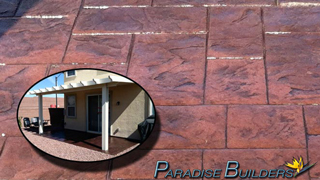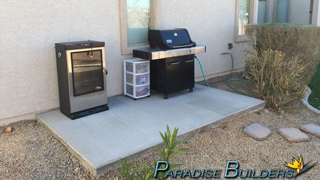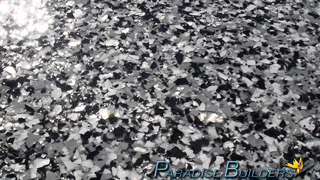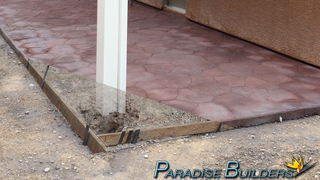Concrete
Walk
Barefoot

What is Concrete?
[con-crete]
"A heavy, rough building material made from a mixture of broken stone or gravel, sand, cement, and water, that can be spread or poured into molds and that forms a stone like mass on hardening."
Concrete Types:
- Concrete Slabs
- Colored Concrete
- Stamped Concrete
- Concrete Overlays
- Concrete Footings
Imagine having your neighbors envy the ground you walk on, with a concrete stamp or overlay it's entirely possible. Concrete technology has advanced to the point that there is now glow in the dark concrete. Let's back up a bit. Concrete as it's typically known is a boring, rough, unattractive necessity in our daily lives. Not anymore. Concrete can be polished to a glass smoothness, colored with opaque and translucent colors, stamped to give an illusion or even coated in metallic flake to mimic high end automobile paint jobs. Concrete is a versatile product that can be beautiful or functional, it's entirely up to the client on the look they desire.
Concrete Slabs

Concrete is a great way to add livable space to any unfinished ground. It's a durable material that will resist the harsh UV environment of Las Vegas. concrete slabs are easily formed and poured, usually in the same day. Due to the nature of the materials, concrete takes on a typical grey color. Slab concrete is usually finished with what's called a light broom finish, giving a slight bit of texture to an otherwise smooth surface. Concrete can also be finished with a hard troweled finish, yet that remains an unpopular alternative to the typical broom finish.
Colored Concrete

Concrete is transforming from a typical grey color, to any color a client can imagine. Colored concrete is becoming an inexpensive alternative to expensive tile and stone floors. Concrete colorings can either be translucent or opaque, basically see-through or solid, and allow for an almost infinite color palette. Metallics are not new to Paradise Builders, yet on the concrete scene, they were trending in 2014. Metallics are a fine, colored flake, similar to the metallic on an automobile paint job. When metallics are applied to a concrete floor the results are always brilliant, the luster is similar to that of a fine diamond, reflecting light in all different directions.
Concrete Overlays

Concrete overlays are a great way to improve the look of existing concrete. The most common overlay is an epoxy garage floor coating, which protects the concrete below from any oil drips or hot tire marks. Epoxy garage floors are easy to clean, regardless of the mess made on top. Motor oil, transmission fluid and gasoline all wipe right off an epoxy garage floor, leaving the garage looking brand new and well maintained all year round.
Concrete Footings

Freestanding Patio Covers or Pergolas, are great for adding shade to any area that does not attach directly to a building. Freestanding Patio Covers require large concrete footings to support the weight and keep the Patio Cover from falling in heavy winds. Concrete footings require city inspections before freestanding patio covers or pergolas can be installed.
Stamped Concrete

Stamped concrete creates the illusion of slate, brick or stone at the fraction of the price. Stamped concrete is a durable alternative to pavers, slate and brick. Stamped concrete is typically only 1/8" to 1/4" thick and can be used with translucent or opaque colors to create any look imaginable. Our most popular texture is a seamless slate that transforms boring concrete into fantastic flooring.
Available Options
- Smooth
- Broomed
- Stamped
- Opaque
- Translucent
- Metallic
- Acid Based
- Water Based
- Integral Color
- Is it expensive?
Concrete by it self, is an inexpensive building material, coloring and stamping materials do add to the price, depending on the selection. - How long does it take to install?
On average it takes 4 days to build a normal patio slab, some can take as long as 2 weeks depending on the detail and coloring of the concrete. - Will it last?
With proper installation and a top quality sealer applied every 5 years, decorative concrete is undoubtedly more resilient than traditional grey concrete. - Do I need a permit?
Depending on where you live, a permit is typically not necessary. *Excluding Footings
